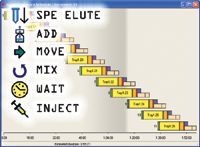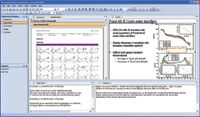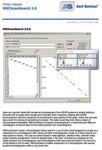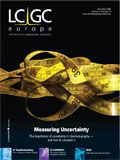Digital Update
Careful synchronization is essential when performing sample preparation and chromatographic analysis in parallel for optimized productivity. Automated sample preparation requires reliable and compatible hardware combined with integrated software control of the whole analysis process, including LC–MS or GC–MS analysis.
Synchronized sample preparation
Careful synchronization is essential when performing sample preparation and chromatographic analysis in parallel for optimized productivity. Automated sample preparation requires reliable and compatible hardware combined with integrated software control of the whole analysis process, including LC–MS or GC–MS analysis. Gerstel's Maestro software can help analysts find the fastest route to the results, according to the manufacturers. The complete process can be viewed using the graphical Scheduler to aid laboratory workflow planning and allows the analyst to monitor important details while viewing the whole picture.

Sample preparation before GC–MS or LC–MS analysis can involve sample clean-up and liquid handling processes, such as additions or dilutions, as well as analyte concentration steps to reach the required limits of detection (LOD). Maestro software supports a range of sample preparation techniques for LC–MS and GC–MS, including liquid handling (e.g., adding an internal standard, derivatizing, extracting or generating a series of calibration standards); automated solid-phase extraction (SPE); dynamic headspace (DHS); automated liner exchange (ALEX); thermal desorption (TD); Twister/stir bar sorptive extraction (SBSE); and headspace and solid-phase microextraction (SPME).
Sample preparation is performed while chromatography of the preceding sample is in progress to optimize throughput. Urgent samples can be inserted into the running sequence without slowing or halting the workflow. If the analysis has been stopped before completion of the entire batch, an e-mail notification can be sent to one or more addresses to quickly restore productivity. Context-sensitive help is available for all functions and entry fields in the software. A remote support tool is also included to enable the Gerstel support team to advise users on trouble-shooting and training if required.
Maestro operates independently or can be fully integrated with the Agilent ChemStation software. Only one method and one sequence table is required to operate the complete system from sample prep to GC–MS or LC–MS analysis.
Website: www.gerstel.com/maestro_eng.htm
Electronic notebook for analytical chemists
The Symyx Notebook is an electronic laboratory notebook (ELN) designed to meet the needs of analytical chemists and biologists. The Notebook allows R&D organizations to replace multiple discipline-specific ELNs with a single, multi-discipline application that can be used across the whole enterprise to accelerate laboratory workflows and improve R&D productivity, according to the manufacturers.

This product consolidates experimental data from multiple domain areas into fully versioned, shareable and searchable documents controlled by customizable document workflows with secure document versioning, electronic signatures and audit trails. This product is the result of close collaboration with several large pharmaceutical and chemical companies and Symyx's extensive experience with electronic notebooks in large, multi-site projects.
The Symyx Notebook contains a full software developer kit to rapidly create custom functionality and extensions, including the incorporation of third-party software and offers enhanced searching and browsing via full-text searching of data-entry forms, experiments, embedded files and annotations. Boolean searching of data-entry forms rapidly narrows-down sets of results.
Citrix compatibility eliminates the need to install the application on researchers' desktops, allowing remote access and enabling operation with Microsoft Windows, Mac OS and Linux operating systems.
This product uses the Symyx Vault document management platform, which supports document browsing and searching; 21CFR11-compliant electronic signatures and audit trails; enterprise-level security; and configurable, highly flexible document workflows with secure versioning for single- and multi-site deployments of all sizes.
Citrix compatibility eliminates the need to install the application on researchers' desktops, allowing remote access and operation with Microsoft Windows, Mac OS and Linux operating systems.
Website: www.symyx.com
MSChromSearch 3.0
Analysts regularly have to compare chromatograms from GC–MS systems or analog detectors. This is usually done visually and can, therefore, be very subjective. GC–MS has the added complexity of comparing the mass of the peaks and doing this manually slows down the process of generating results. MSChromSearch compares chromatograms in a short time and offers an unambiguous numerical value for the match between two chromatograms.

The software makes a chromatogram library search in a set of other chromatograms as simple as comparing a chromatogram with a library of other chromatograms — similar to a library search in a mass spectrum library. The user can select between mass spectrum, retention time, retention index and/or intensity comparisons. From the selected data a "fit value" is formed as a measure for the match between two chromatograms, and chromatograms that were found are listed in the form of a hit list based on the fit value. MSChromSearch enables the comparison of a chromatogram with several hundred chromatograms in a short time, according to the company.
Website: axelsemraude.de
Detecting Hyper-Fast Chromatographic Peaks Using Ion Mobility Spectrometry
May 6th 2025Ion mobility spectrometers can detect trace compounds quickly, though they can face various issues with detecting certain peaks. University of Hannover scientists created a new system for resolving hyper-fast gas chromatography (GC) peaks.
University of Oklahoma and UC Davis Researchers Probe Lipidomic Profiles with RP-LC–HRMS/MS
May 6th 2025A joint study between the University of Oklahoma Health Sciences Center (Oklahoma City, Oklahoma) and the UC Davis West Coast Metabolomics Center (Davis, California) identified differentially regulated lipids in type 2 diabetes (T2D) and obesity through the application of reversed-phase liquid chromatography-accurate mass tandem mass spectrometry (RP-LC-accurate MS/MS).
Automated Sample Preparation (ISO 20122) for MOSH/MOAH in Seasoning Oils
May 6th 2025This work presents an Automated Sample Preparation procedure for MOSH/MOAH analysis of Seasoning Oils. We compare results from a manual epoxidation procedure compliant with DIN 16995 with results based on fully automated sample preparation (epoxidation and saponification) compliant with ISO 20122. In both cases, online clean-up via activated aluminum oxide (AlOx) are used to remove interfering n-alkanes from the MOSH fraction during the HPLC run. Automated data evaluation using a dedicated software (GERSTEL ChroMOH) is presented.

.png&w=3840&q=75)

.png&w=3840&q=75)



.png&w=3840&q=75)



.png&w=3840&q=75)










